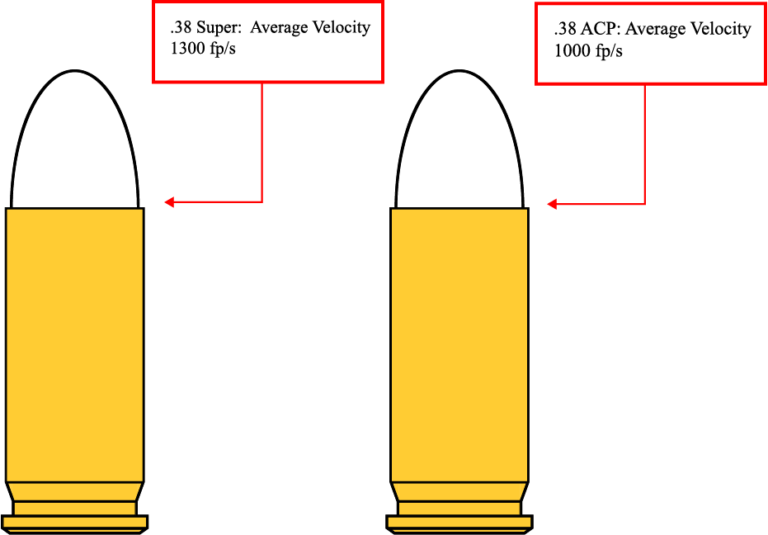Condition

The "other" 1911 round
The 1911 is not exclusively the domain of the 45 ACP. In fact another cartridge the .38 Super has for just as long been a mainstay of the 1911 platform. The .38 Super, or .38 Super Automatic, has a long and storied history dating back as far as 1929. Perhaps no other cartridge has is quite of an interesting and varied history as the .38 Super, from humble beginnings as a more powerful .38 ACP, to serving time in Latin American gang wars and shootouts with the police, and then finally finding a home as the go to race gun round for many IPSC shooters. The cultlike following, incredible ballistics, and continued endurance despite many obstacles make the .38 Super an excellent choice for a wide variety of shooters the world over.

Table of Contents
Small Beginnings
The .38 Super was initially created in the late 1920s as a much higher pressure loading of the .38 ACP. By increasing the pressure of the cartridge the .38 Super was able to achieve about a 300 ft./s increase in the velocity of a 130 grain bullet, going from 1000 ft./s to roughly 1300 ft./s. With this increase in speed also came a nearly 200 foot pounds of force increase when using the same weight of bullet. During the initial release of the cartridge the .38 Super face strong competition from the .357 Magnum. Many police departments still relied on traditional revolvers and were hesitant to make the move over to semi-automatic firearms.
The .38 Super was initially created in the late 1920s as a much higher pressure loading of the .38 ACP. By increasing the pressure of the cartridge the .38 Super was able to achieve about a 300 ft./s increase in the velocity of a 130 grain bullet, going from 1000 ft./s to roughly 1300 ft./s. With this increase in speed also came a nearly 200 foot pounds of force increase when using the same weight of bullet. During the initial release of the cartridge the .38 Super face strong competition from the .357 Magnum. Many police departments still relied on traditional revolvers and were hesitant to make the move over to semi automatic firearms

Adventures in Latin America
While missing its chance as a military or police cartridge, .38 Super found it a less than reputable home with gangsters and law enforcement in Latin America. The primary reason that .38 Super handguns found themselves as the go to weapon for these less than reputable characters was that it was not a “military” cartridge, and thus not restricted in many countries such as Mexico and others in South America. This came with the added benefit of the fast and hard-hitting round being able to penetrate many car doors and bullet proof vests of the 1930s. These combined characteristics saw many .38 Super rounds fly from both sides in police versus gang shootouts. The round may have stayed on the streets of Latin America, but the IPSC shooters discovered the sleeper cartridge and saved it from a life on the streets.
Life At the Races
When the IPSC first started many shooters experimented with different loadings of various calibers and even created new wildcat cartridges. However when the competition shooters discovered in the .38 Super, they discovered a cartridge that fulfilled many of their needs. The .38 Super in a 1911 or other single stack pistol offers a number of advantages to the IPSC shooter over the .45 ACP. First a standard size magazine was able to hold nine rounds, plus an additional round in the chamber, more than the seven or eight round standard magazines for the .45 ACP. Second, with the lighter bullets of the .38 Super shooters found that the round delivered less recoil, that could be tamed even further with a compensator.

The low recoil allowed for faster follow-up shots, and in a competition where the difference of hundreds of a second matters, this proved to be a deciding factor in the popularity of the cartridge. Finally the .38 Super was able, due to its velocity relative to the weight of the bullet, to compete in the major power factor of the IPSC. With these new inroads in the competition shooting arena the .38 Super found itself also being used as a personal defense round in far more reputable circumstances than it had before on the streets of Latin America. However the .38 Super once again found itself overshadowed by the popularity of another round.
Battle Of The 9mm's
While gaining popularity as a rounding competition shooting, the 80’s and the 90’s saw the reign of another caliber, also firing a 9mm bullet. Semi automatic, high-capacity, “wonder nines” became popular with many law enforcement agencies, around the same time the US military also moved to the Beretta M9, another 9mm handgun. The civilian market, keen to follow in the footsteps of what the police and military were using to defend themselves, made these handguns extremely successful. The .38 Super also had other obstacles to overcome. The inherent design of the cartridge made it less reliable in double stack magazines, then the single stack magazines that it had originally been designed for. Some versions of the case for the .38 Super feature a decreased rim size of only .003-.004″ when compared to the standard specification of .007-.009″. This small change allows for more reliable feeding when the round is used in double stack magazines. However, these rounds are intended for handguns that headspace at the mouth of the case. Head spacing from the mouth of the case instead of the semi-rim allowed for greater accuracy to be produced from 1911 style pistols. Before this change, accuracy of .38 Super handguns suffered, and this improvement help to spur adoption in competition shooting circles. Over the years the design of the brass has also seen some changes, with thickening in key areas to help contain the increased pressures of the cartridge.
Loading Data
Hand loaders will find a large amount of data for a variety of loadings from Shooters Reference.Com
As far as factory ammunition goes shooters will find a variety of manufacturers producing quality ammo both for use at the range and for serious self-defense applications. Fiocchi, Magtech, Winchester, and Remington all produce excellent full metal jacket range ammunition. For defensive applications Winchester, Buffalo Bore, Cor Bon, Doubletap, and Glaser all produce ammunition well-suited for self-defense.
Chambered Firearms & Accessories
With its long history as a competition shooting round the most commonly found handguns chambered for .38 Super are going to be 1911 style race guns. As with all 1911’s holsters, magazines, and other accessories are not difficult to find, if on occasion somewhat expensive.
In addition to this EAA has created a number of high-capacity handguns chambered for the .38 Super. These EAA Witness handguns utilize double stack magazines, and thus any versions chambered for .38 Super are best served by using ammo with a smaller rim size than the original factory specification. While lacking the ubiquity of high-capacity handguns such as Glock, the EAA Witness still has a wide selection of holsters and magazines available for it.
2025 Update:
Availability has changed somewhat over the years and while there are still new factory models available, double stack pistols seem to have become more difficult to find.
A Strong But Small Following
We say the .38 Super is on life support because it does not have the widespread appeal of other calibers such as the 9mm, .45 ACP, and the .40 S&W. However, the .38 Super maintains a loyal following from many shooters in competition and self defence circles. This sleeper cartridge has retained a loyal yet small following and while not as popular as it once was it still remains a viable competition shooting cartridge, and with its ballistic potential it remains a viable defensive cartridge to this day. The .38 Super’s parent cartridge the .38 ACP was designed for use in the 1911 platform and any fan of the 1911 platform should consider taking a look at the .38 Super especially given the potential of the cartridge in a variety of applications.

